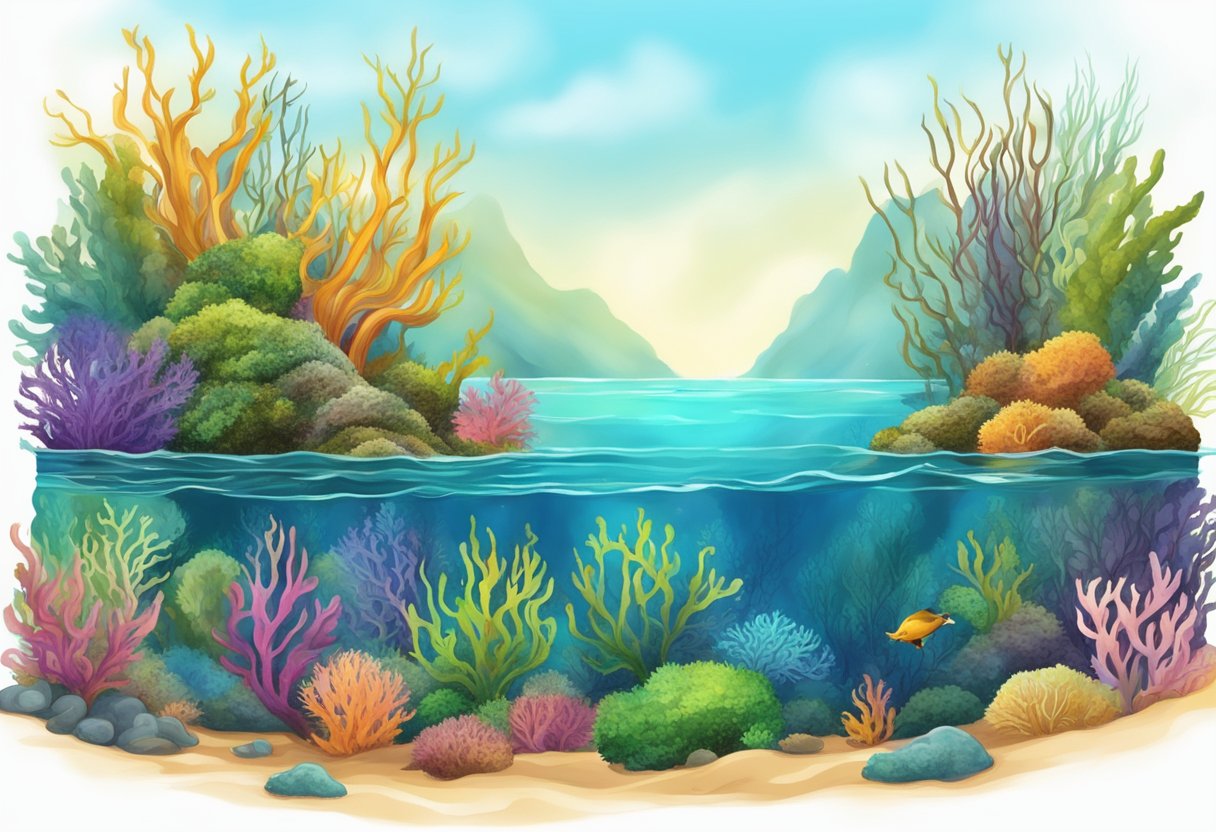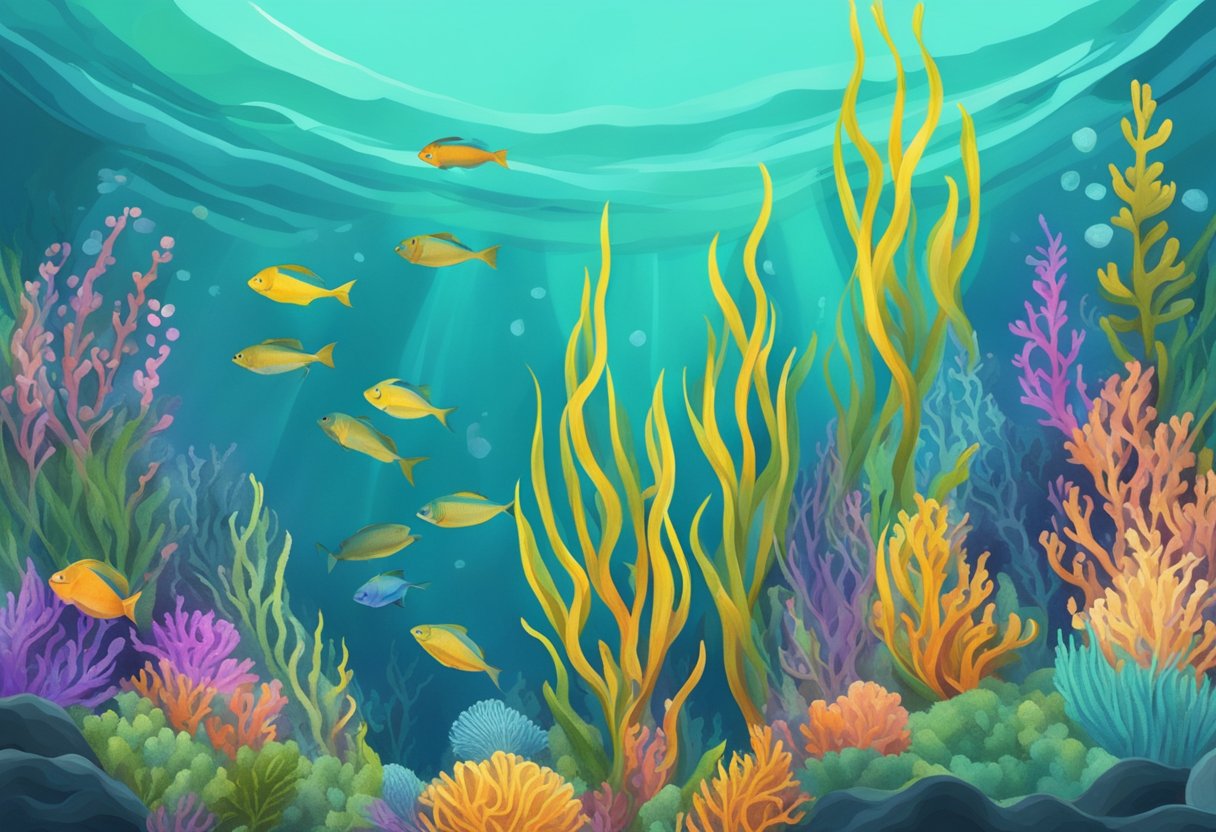Kelp and sea moss are both types of seaweed that have gained popularity in recent years due to their potential health benefits and versatility in culinary applications. Although they share some similarities, there are also distinct differences between the two that are important for consumers to understand when choosing the best option for their needs.
Kelp, a large brown seaweed, is primarily known for its high levels of essential nutrients, including iodine, potassium, and calcium, which contribute to its reputation as a superfood. Sea moss, on the other hand, is a red seaweed that is rich in protein, vitamins, and amino acids, and has been touted for its potential to improve digestion and soothe the skin. They both grow in different environments, with kelp thriving in cooler waters while sea moss prefers warmer seas.
To provide an accurate comparison of kelp and sea moss, a comparative analysis will cover their nutritional contents, usage in culinary applications, health benefits, and consumer preferences to enable readers to make informed decisions.
Key Takeaways
- Kelp and sea moss are both nutritious seaweeds with unique benefits.
- Kelp is known for its essential nutrients while sea moss offers protein, vitamins, and amino acids.
- A comparative analysis will provide insights into their uses and benefits for consumers.
Overview of Kelp

Habitat and Cultivation
Kelp is a type of large brown seaweed that grows in shallow, nutrient-rich saltwater near coastal areas worldwide. It belongs to the Laminariales order of algae and is commonly found in underwater forests called kelp forests. Kelp thrives in cold waters and forms a crucial part of marine ecosystems.
Nutritional Composition
Kelp is highly nutritious, and presents a rich source of vitamins, minerals, and antioxidants. Key elements found in kelp include:
- Iodine: Essential for thyroid function and critical to healthy metabolism.
- Vitamins: A rich source of vitamins A, B1, B2, C, D, and E, promoting overall health.
- Minerals: Kelp consists of many essential minerals such as calcium, magnesium, potassium, and iron.
Common Uses
Kelp has a wide range of uses and applications, including:
- Food: Kelp serves as an ingredient in various dishes and food products, such as salads, soups, and sushi. It is also processed into a powder form and used as a supplement or seasoning.
- Cosmetics: Due to its high mineral content and moisturizing properties, kelp is an ingredient in various skincare products, including facial masks, body scrubs, and creams.
- Animal feed: Kelp meal is utilized in the livestock industry as a nutrient-rich feed supplement for animals.
Environmental Impact
Kelp forests provide crucial ecosystem services, such as:
- Carbon sequestration: They absorb and store large amounts of carbon dioxide, mitigating the effects of climate change.
- Habitat support: Kelp forests serve as a home to numerous marine species, promoting biodiversity and sustaining fisheries.
- Coastal protection: The root-like structures of kelp help reduce wave energy, preventing erosion and maintaining shoreline stability.
When comparing kelp to sea moss, both serve as valuable sources of nutrients and contribute to healthy ecosystems. However, kelp is a more dominant presence in ocean habitats, playing a larger role in carbon sequestration and supporting a greater variety of marine species.
Overview of Sea Moss

Types and Species
Sea moss, commonly known as Irish moss (Chondrus crispus), is a type of red algae found in the shallow waters of the Atlantic Ocean. There are many other species of sea moss, such as Gracilaria and Eucheuma, found in various regions worldwide. When comparing sea moss and sea kelp, they differ in terms of structure and size, with sea kelp being classified as brown algae and typically larger in size.
Nutritional Value
Sea moss is popular for its high nutritional content, containing essential minerals and vitamins, including:
- Calcium
- Iron
- Magnesium
- Potassium
- Vitamin B complex
- Vitamin C
It also contains carrageenan, a natural substance that is often used as a thickening or gelling agent in various food products. Sea moss is considered lower in iodine content compared to sea kelp, which may be advantageous for individuals with specific iodine intake requirements or thyroid issues.
Therapeutic Uses
Sea moss has experienced a surge in popularity due to its potential therapeutic applications. Some claimed benefits of sea moss include:
- Immune support: The rich vitamin C content in sea moss is associated with improved immune function and antioxidant properties.
- Skin health: Minerals such as magnesium and calcium may help maintain healthy skin and promote hydration.
- Digestive health: The gel-like consistency of sea moss is thought to help alleviate gastrointestinal issues by soothing the digestive tract.
It is essential to note that more extensive research is required to validate these therapeutic claims fully.
Sustainability Issues
Sea moss farming has proven to be an environmentally-friendly and sustainable practice, with controlled cultivation in various locations across the globe. Harvesting it from the wild, however, could contribute to sustainability concerns if not managed properly. Comparatively, sea kelp cultivation faces similar issues, making it crucial to ensure responsible harvesting and farming practices for both types of seaweed.
Comparative Analysis

Nutrition Comparison
When comparing the nutritional content of sea kelp and sea moss, both offer essential vitamins and minerals. Sea kelp, being a type of seaweed, is rich in iodine, calcium, and potassium, while sea moss is known for its high iron and magnesium content. It's important to consider the specific nutritional needs when choosing between these two marine plants.
Health Benefits Analysis
In terms of health benefits, both sea kelp and sea moss contribute to overall well-being. The high iodine content in sea kelp supports thyroid function, while its calcium and potassium content contribute to bone health. On the other hand, sea moss provides benefits related to immunity and digestion, thanks in part to its iron, magnesium, and antioxidant properties. Seaweed vs Sea Moss provides helpful information about the differences between these marine plants and their wide-ranging health benefits.
Usage in Culinary Contexts
Both sea kelp and sea moss have unique culinary applications. Sea kelp is often used in Asian cuisine, with its leaves being a popular ingredient in soups, salads, and sushi rolls. Sea moss, on the other hand, is traditionally used in Caribbean and Irish recipes. It can be made into a gel that can be added to smoothies, desserts, and even vegan cheese. Their versatility makes them both valuable additions to various dishes and recipes across different cultures.
Sustainability and Eco-Friendliness
From an eco-friendly standpoint, both sea kelp and sea moss can be grown and harvested sustainably. Their ability to reproduce quickly and their minimal requirements for nutrients make them an appealing choice for environmentally conscious consumers. Additionally, as they don't compete for land or freshwater resources, their cultivation has less impact on the environment compared to traditional crops.
Consumer Insights
Market Trends
Over recent years, there has been a growing interest in sea moss and sea kelp as natural health supplements and food additives due to their rich mineral and nutrient content. Both of these marine plants have gained popularity in the health and wellness industry, finding their way into various products – from nutritional supplements to beauty and skin care items.
Some key market trends include:
- Increased demand for natural and organic products
- Focus on sustainable harvesting and production methods
- Rise in popularity of marine-derived ingredients in various industries
Note: It's important to remember that market trends may vary between regions and consumer segments.
Consumer Preferences
When it comes to sea moss vs. sea kelp, consumer preferences tend to be influenced by factors such as personal health goals, dietary restrictions, and regional availability.
-
For sea moss, consumers often seek products that are wildcrafted or sustainably harvested, as well as those with minimal processing to preserve its natural benefits. Sea moss is favored for its high mineral content, particularly its richness in iodine, calcium, and magnesium. It is commonly found in products like smoothie additives, gels, and vegan thickeners.
-
Sea kelp, on the other hand, is known for its high concentration of vitamins A, C, E, and K, as well as minerals like potassium, zinc, and iron. As a result, it is a popular ingredient in dietary supplements and beauty products such as face masks, serums, and creams. Consumers often look for kelp that is sustainably harvested and free of contaminants.
Product Availability
Product availability for sea moss and sea kelp varies by region and market demand. In general, both of these marine plants can be found in the following forms:
- Raw: Consumers can purchase sun-dried sea moss or fresh kelp, which can be rinsed, soaked, and added to various recipes.
- Powdered: Easily soluble in liquids, powdered sea moss and kelp are convenient for adding to smoothies, shakes, or even as a seasoning.
- Supplements: Capsules and tablets containing sea moss or sea kelp can be found in most health food stores, accommodating convenient daily intake. Some combinations include other beneficial ingredients such as bladderwrack, a type of seaweed.
While sea moss and sea kelp are both available in various forms online and in stores, consumers should always research product quality, harvesting practices, and overall safety to make the most informed decision for their personal needs.





